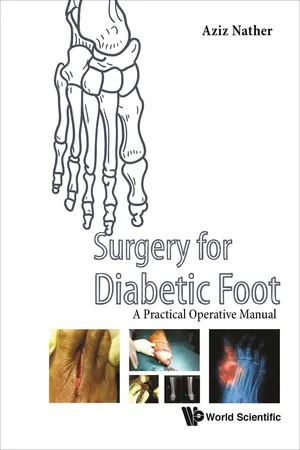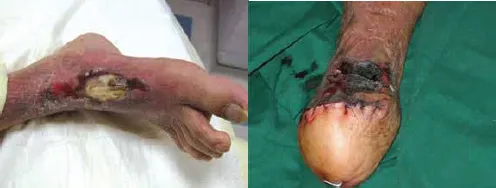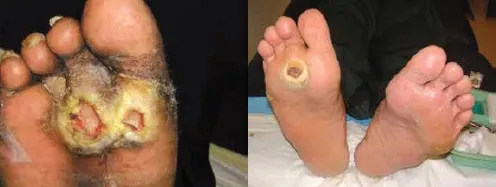
- 452 pages
- English
- ePUB (mobile friendly)
- Available on iOS & Android
About this book
This is the first textbook on surgery for Diabetic Foot in the world. It is written as a practical surgery manual for residents and young surgeons performing surgical procedures for patients with diabetic foot problems. Such a guide will be useful not only to residents and surgeons in Singapore but also to our neighbouring countries including, Malaysia, Indonesia, Hong Kong, India, Sri Lanka etc.
Each surgical procedure is written in a systematic fashion covering indications, pre-operative preparation, anaesthesia, patient positioning, operative technique (in step by step fashion and illustrations) and post-operative care.
The scope covers all aspects of surgery for diabetic foot from surgical debridement, split skin grafting, surgery for osteomyelitis, minor amputations including ray, transmetatarsal, Lisfranc, Chopart and Modified Pirogoff amputation to major amputations such as below knee, through knee and above knee amputation. It also includes assessment for revascularisation and revascularisation procedures.
This book will serve as a useful practical guide for training surgical residents and for surgeons aspiring to do diabetic foot surgery.
Frequently asked questions
- Essential is ideal for learners and professionals who enjoy exploring a wide range of subjects. Access the Essential Library with 800,000+ trusted titles and best-sellers across business, personal growth, and the humanities. Includes unlimited reading time and Standard Read Aloud voice.
- Complete: Perfect for advanced learners and researchers needing full, unrestricted access. Unlock 1.4M+ books across hundreds of subjects, including academic and specialized titles. The Complete Plan also includes advanced features like Premium Read Aloud and Research Assistant.
Please note we cannot support devices running on iOS 13 and Android 7 or earlier. Learn more about using the app.
Information
1
Diabetic Foot Wounds — Types of Wounds and Classification Systems
Introduction
Pathogenesis

| 2014 | 2030 | |
| Total world population (in billions) | 7 | 8.3 |
| Adult population (20–79 years, in billions) | 4.4 | 5.6 |
| Number of people with diabetes (in millions) | 387 | 552 |
| Global prevalence of diabetes (%) | 8.3 | 9.9 |
Types of Wounds
Infective Wounds
Ischaemic Wounds


Both Infective and Ischaemic
Neuropathic Wounds


Decubitus Wounds
Classification Systems
Wagner-Meggitt Wound Classification
Table of contents
- Cover page
- Title page
- Copyright page
- Dedication
- Contents
- Preface
- Introduction
- About the Editor
- List of Contributors
- 1. Diabetic Foot Wounds — Types of Wounds and Classification Systems
- 2. Value of Team Approach
- 3. Clinical Examination of Diabetic Foot
- 4. Investigations
- 5. Medical Treatment
- 6. Antibiotics for Diabetic Foot Infections
- 7. Surgical Debridement
- 8. Split Skin Grafting
- 9. Negative Pressure Wound Therapy for Management of Diabetic Foot Wounds — Basic Science, Clinical Applications and Future Developments
- 10. Osteomyelitis in Diabetic Foot
- 11. Surgery for Osteomyelitis
- 12. Minor Amputations
- 13. Ray Amputation
- 14. Transmetatarsal Amputation
- 15. Midfoot Amputations
- 16. Modified Pirogoff Amputation
- 17. Major Amputations
- 18. Below-Knee Amputation
- 19. Through-Knee Amputation
- 20. Above-Knee Amputation
- 21. Assessment of Circulatory Status in Patients with Foot Ulcer or Gangrene
- 22. Revascularization for Limb Salvage in Critical Limb Ischemia Patients
- Appendices
- Sponsors